#stingless wasps
Explore tagged Tumblr posts
Text

I forgot to show you all this cool wasp I found when I was hiking in old growth forest in Missouri last month! She's an Atanycolus species, probably A. cappaerti, and she's a native stingless wasp found primarily in the eastern half of the United States. You can tell she's stingless because she has a long, skinny ovipositor at the end of her abdomen instead of a shorter, sharper stinger.
In fact, stingers are just modified ovipositors found in some members of the order Hymenoptera (wasps, bees, ants, sawflies). Originally the structure evolved so that the female could inject her egg into a safe place, whether that was a leaf or stem of a plant, or a hapless insect or spider host. But some species changed it through evolution so that it not only could more easily penetrate the skin or exoskeleton of an attacker, but inject venom as well. This not only allows some parasitic wasps to more effectively subdue and paralyze their hosts, but defend themselves and their nests as well.
A. cappaerti has a variety of insect hosts, but I was delighted to hear that this species will readily parasitize larvae of the invasive emerald ash borer (Agrilus planipennis). And even better news--there are other native wasps that also use the ash borer as a host! All of which means these native wasps could be used for intentional biocontrol of the invasive insects without having to bring in non-native parasitic wasps.
#wasps#wasp#insects#bugs#Hymenoptera#stingless wasps#animals#wildlife#nature#native species#invasive species#emerald ash borer#ecology#conservation#invertebrates#arthropods#Missouri#Ozarks
27 notes
·
View notes
Text

An old photo from October 2016. Note that all these individuals are males and are therefore, stingless. Polistes dominula - European paper wasps. ♂️
#hymenoptera#entomology#insect#wasp#wasps#apocrita#aculeata#vespoidea#vespidae#Polistinae#Polistesdominula#EuropeanPaperWasp
440 notes
·
View notes
Text
Building a Hornet’s Nest
Male Wasp Hybrid Harem x Feminized Male Reader (CW: Noncon, musk, pheromones, bukkake, gangbang, double penetration, wasp men, oviposition, feminized male reader, drug-like cum, wasp transformation, DNA manipulation, general yandere behavior) Word Count: 3.7k (Sorry that this took so long. Sorry that this is so weird. I hope some people can find the degeneracy within themselves to enjoy it.)
When your distant uncle had passed away and left you a property you were surprised to say the least. You were more surprised to learn that it was on Arcadia and that your uncle had never lived long enough to go and see it as he had been ill for some time before his passing and he was not particularly old either. Years ago, unknown to most of the family, he had procured a modest plot of land on Arcadia, a distant planet on the fringes of known space. A true modern day frontier. It was known for its mega-flora. With flowers that grew to the size of trees in some cases. It was also known for its giant docile bees. They were just like bees on Earth except much much larger and they were stingless, it was very easy to domesticate them and now people used them on Arcadia to develop many rare and exotic honey types from the strange alien flowers. Your uncle had wanted to be a beekeeper, he was apparently going to invite you on the venture with him seeing as how you were both into farming and working the land and you had helped him with his beekeeping when you were younger, but he never recovered from his illness so you did not find out until his death. With only a bit of hesitance you decided to pursue your uncle’s dream. When you first got to Arcadia you were in awe by how tranquil and picturesque it was, the pictures and videos that you had seen certainly did it no justice. Unlike Earth most of the foliage was various shades of red, orange, and yellow. Giant blooms of every shape and color imaginable were everywhere, with the exception of the clearing that a small settlement had been built in. Despite being here for a few decades it was still very much a quaint little frontier town, pleasant enough people, offering just the bare essential services. Then there was your new plot of land a few miles from town. It was… run down… to say the least. But you made due, you had sold everything of significant value that you had owned back on Earth and were fully committing to this new venture. And, after a few months, your efforts finally paid off. A giant mansion sized barn for your future bees was built and your house was repaired. All that was left to do was wait for your shipment of buzzy friends to arrive. Well they wouldn’t be so busy when they arrived, as they would still be pupa, but within a week or two the pupa would be finished developing into full sized giant docile bees, they would accept the barn as their home and set up shop. The day came when your shipment finally landed and you were so thrilled, they came off the hover truck and you hurried them into their new home, carefully placing them horizontally into cells in the walls and capping them. In truth you had been more than a bit worried, you were running perilously low on funds and had to go with a discount bee supplier that seemed just a slight bit unreliable. But it seemed you had worried for nothing, here were your bee pupa, nice and healthy. Though they did seem to be a slightly different shape than they looked from the advertisements and videos, you were sure that nothing was wrong. You could barely contain your excitement, you had heard that these bees easily imprint on their humans and are very loving, soon they would establish a hive and your goals would be obtained. It would be slow at first, as you only had enough to get three pupa, but you would get there eventually. You couldn’t stop yourself from checking the barn every few hours. 9 or 10 times each and every single day. The wait was torture. But finally, after about 12 days, you heard buzzing coming from the barn when you stepped out of your house in the morning, you practically tripped over yourself running back inside to grab the collars for them and then dashed back outside and across the field of flowers you had started to grow for them. You opened the door to the barn and… it was NOT what you were expecting. The three pupa were no longer in the cells you had packed them so lovingly into, but they sure as hell were not bees either. Instead, standing before you were three wasp-men. You knew what these were, genetically engineered human-wasp hybrids, that typically had smaller genetic contributions from several ant and bee species as well, that were typically used in highly regulated projects or otherwise extremely shady sources of labor on the very unregulated frontier planets. The question was how did you get them? Did someone’s order get mixed with yours? With how much energy and enthusiasm you opened the door with, they were all now intently staring at you, and to say that they were intimidating would have been an understatement. They all looked fairly similar to one another, red and yellow plates of chitinous exoskeletons covered their feet, arms, legs, chests, and backs. The only thing lacking the exoskeletons were their faces, abs, asses, and crotches. Which were very much exposed, showing off scarily long cocks and heavy balls. They had red bug-like eyes, they had fangs but otherwise regular mouths, but they sat between a set of wicked looking mandibles. Antenna twitched on their heads, sticking out from long blood red hair. Each had a set of large wings folded behind them. Their antennas twitched in your direction as they also sniffed the air curiously. Uh-oh. They were from a shady source so who knows how unpredictably they could act towards you, so you wisely decided to make a hasty retreat, but they quickly flew over to you and pulled you back deeper into the building. “Where’s the rush?” one of them inquired in a slightly buzzing but deep voice, “Me and my friends just woke up here and need some answers.” “Uh-uh okay, sure, what do you want to know?” The one speaking put his arm roughly around your waist and pulled you closer to him. “Well, we are looking for the person meant to be our queen, do you know where they are? Your scent is the only one here. Did you put us in the wall compartments?” “There isn’t any queen, but y-yeah I was the one who bought your pupa and put them in there.” He took a moment to feel you over with his antenna, it probably would have tickled had you not been scared shitless. “Sooo… you’re the queen? Or are you under someone??” “There isn't one! And I own this land and made this building for bees…” One of the other two wasp men chimed in at this. “Ha! Bees? Those weak passive ones that have no human in em and are about as smart as a pet dog? You’re lucky you got us instead, we are far superior!” The one holding you now much too tightly replied while flexing his free arm,”He’s right, we are much better. You really lucked out little queen~ We can keep you much safer.” He licked up your neck with a long narrow tongue making you shiver. “I told you, there isn’t a queen!” You were beginning to grow annoyed with the cyclic nature of this conversation. “You bought us? You own this territory? You put us in cells so we could grow?” “W-well yeah but… I’m n-not-” “You’re our queen then~ Don’t be scared we’ll keep you all safe from the big scary world! You’re far too weak and squishy to just be left alone.” “Ha! Yeah, just a pathetic squishy little human,” the third one that had been silent up until now chuckled as he poked you hard in the stomach. The one holding you grinded gently into your ass, his cock fully erect and prodding your cheeks. “This ass is soft too~ Bet it feels great inside, doesn’t it little queen?” “S-stop, please, I’m not a w-woman!” “Awe, our queen is a bit dumb too~ Good thing we came along to take care of you. It doesn’t matter if you don’t think you’re our queen yet, we’ll rape you full of our eggs. You’ll look so lovely full of our spawn~” As he said all of this he began to gently rub his hand against your crotch and the other two hybrid men stepped closer. Between the unwanted touching and the mention of the word rape you decided it may be worth the risk to try and escape anyway, but your struggles didn’t last long. The man holding you shook you a bit violently until you were unsteady and still and then held the top of his wrist to your neck. A long thick black needle protruded from his wrist and was pointed at you threateningly. You turned away, trying to put as much space between your neck and the sinister looking needle as possible. “Maybe you aren’t too dumb, you know what this does don’t you my queen? It’ll hurt terribly before paralyzing you and allowing us to play with you at our leisure and make you fulfill your royal duty~” You let out a pathetic whimper in response. “Oh, don’t worry, I don’t want to use it. How can you squirm around my dick if I did? So just relax and let this happen the easier, more fun way, okay?” He nibbled on your earlobe and you went completely limp in his grasp, signaling that you wouldn’t put up anymore of a fight. “Heh heh, excellent choice, my queen~” The other two wasps chuckled cruelly as well as one pulled your shirt off and the other wasted no time in unburdening you of your pants and boxers. They stared at you hungrily. Your nudity only fueled your fear and you had to stifle your instinct to flail, thrash, punch, and run. But doing so would surely make things much worse for you, better to just let them have their way and get it over with and hope you could sneak out after maybe when they were sleeping or otherwise distracted. You could feel the cock of the hybrid behind you gently rubbing against your hole as he licked and bit at your neck. He bent down behind you and spread your cheeks, making you shudder as an inhumanly long tongue prodded your hole before sliding in deep, stretching you out gently as it probed and making you twitch and grow hard as it found and focused on your prostate. The genetics for their tongues definitely came from long tongued bees. The wasp man behind you got up and resumed pressing his cock into your hole. “Just getting you good and ready queen~” He whispered softly into your ear. His large cock mercifully massaged copious amounts of thick precum into you to prep you for breeding. At least the entry wouldn’t be unstretched or dry, because that’s not something you would have put past them. The other two wasps were busy rubbing their hands all over your body, rubbing your belly, groping your ass cheeks, stroking your face with surprising tenderness, and contrasting that with rough greedy groping of your soft thighs and tugging at your hair. As the one behind you slipped inside your well lubed ass a second wasp enveloped your hard cock entirely within its mouth while the third kissed you passionately, its tongue fervently exploring every inch of your mouth. You couldn’t even yell in pleasure or protest the pain of having your ass invaded by a large inhuman cock as the long thin went down your throat, making you gag a bit. Finally respecting your need to breathe, the wasp removed itself from your face and began biting your sensitive neck, adding to the complete overly stimulating waves of sensation already being caused by having your dick enveloped by a hot mouth and your prostate gently kissed by the rhythmic thrusts of the other two insectoid men. The one attending your cock took his free hand to massage your balls and that led you to possibly the quickest orgasm of your life. In any other situation you would have been totally humiliated, but you were long past having any dignity today. The one behind you did not relent in his fucking of you, but instead picked up the pace a bit as he felt your body shudder, the one sucking you off hungrily swallowed your load before licking his lips and getting up. “My, you were really pent up my queen, and you produce such sweet honey for me!” He pressed his lips to yours, letting the taste of your own cum permeate your mouth. Between the kiss and the constant pounding of your ass you whimpered as you were already hard again, the wasp that had previously had its tongue down your throat now replacing the one that swallowed your cum at your cock, kissing the sensitive organ before licking it and sucking your recently emptied nuts. You whimpered as they continued to manhandle your sensitive body. The one pumping into your tight hole finally slamming in hard and cumming forcefully, depositing something round and hard into you as he did, making you flinch a bit in surprise as you remembered that they reproduced via eggs, it did not really hurt, but you felt a tingling inside where the waspoid cum touched you. The cock inside you lingered a while as it filled you but once it slid out and away from you your ass’ rest was short lived. One of the wasps laid with his back on the ground and with his cock pointing up, the other two bringing you over to him and forcing you to lower yourself onto his eager, drooling, prick. Your well stretched hole slid on him easily and he gripped you tight and forced you up and down on his length. That special spot inside you was rubbed once more, making you shudder in unwilling pleasure, your body completely betraying you. The pace was slow enough for you, and surprisingly he seemed unwilling to seriously injure his “queen”. As you were finally getting used to the motions one of the other wasps, the one that had already filled your ass, came up behind and slid his cock back inside you with his friend’s so that you were now being plowed in tandem by the both of them. As you gasped from the sudden extra intrusion abusing your insides the third wasp took advantage of your open mouth and wasted no time in putting his dick in your open mouth. You could taste his precum, oddly enough it had just a slight soothing effect and you noticed it tasted of honey. Filled to the brim with cock, you started to get a bit more relaxed as time went on, not overly so. You were still very unwilling and any pleasure was purely physical, incidental, and frustrating, but whatever was in the honey like fluid dripping from his cock was definitely making you a bit less stiff and just a tad bit less defiant. While this was happening you thought you could remember hearing something about this, that modified wasp and bee species made substances that could calm down their queens when distressed, both in fluids and via pheromones. And now that you thought about it the musk that hung heavily in the air was strangely comforting, it was like the more of the precum that dripped down your throat the more you were affected by the smell that these men were giving off. Not nearly enough to really lose yourself though, it was far more subtle than that. It was also probably why you did not feel too much pain anymore despite two dicks pistoning your ass, as one cock thrust forward the other pulled back. All the while the one occupying your mouth was happily pumping away, content with enjoying the wet warmth of your mouth as he fed you more pre. Between all the sensations overtaking your body, the cocks sliding in and out of you, the pheromones and relaxing fluid, and the hands roaming over your sides, face, and thighs, you couldn’t help but blow another load, right on the wasp that was below you. “See? It feels good to be our queen, doesn’t it,” he asked with a mocking chuckle knowing full well it was just your body’s response and it didn’t mean you were enjoying your predicament. After several minutes the one making you suck him pulled out and moaned as he came all over your face, covering you in warm slippery fluid. There were no eggs in this ejaculation, he was certainly saving all of those to be deposited deep inside you to go along with his friend’s. Your skin tingled a bit where the cum touched you and you began to feel just a bit dizzy as your inhibitions slowly lowered just a bit and you became even more relaxed. The cum was much more potent than just the precum and the load up your ass was gradually affecting you as well. Musk permeating the air was much thicker than it had been, or maybe you just noticed it more now, but it was making you drool a bit and you couldn’t help but bounce back a bit against the dicks in your suddenly hungry hole. “I feel really weird… can we stop now…” You stifled a cry, something wasn’t right, you were much more sensitive than normal to everything and you were having difficulty thinking clearly. The wasps all smirked as they ignored you, knowing that their fluid was slowly turning you into a weak little queen they could worship and fill with egg after egg. It was slowly changing your very DNA, making you receptive to hybrid pheromones, making you crave them. The one that had previously unloaded in you pulled out and came all over your back. Moments later the one below you working you on his shaft like some kind of living sex toy slammed you down to the base of his cock and filled you deeply with even more eggs and semen, causing you to spasm and moan weakly with a dry orgasm of your own. “Fuck! You’re a great incubator!” While you were panting and trying to recover the wasp previously abusing your mouth unceremoniously pulled you off the cock you were on and gripped you tight from behind, his erection easily sliding in your cum leaking entrance. “Not done yet, being queen is very busy work, you have to take my eggs too~” “P-please no more, I-I feel funny,” you pleaded desperately as your head was swimming with mixed signals. You knew you didn’t want this but you were so light headed you could barely think, and now these wasp men smelled so alluring, and wouldn’t having more eggs in you feel so nice? “I-I n-need to s-stop…” You felt an instinctual need to keep letting them fill you up, but at the same time you were burning up and truly felt feeble and sick. “Shhh, shhh, just relax, okay? You have been such a good mate for us so far~” He licked a long stripe up your neck with his thin tongue and held you tighter as he continued grinding into you. Without warning he started flying a few feet in the air while still breeding you, his insect instincts telling him to give you a proper nuptial flight. In no time the other wasps joined in as well, both of them in front of you, tending to their precious queen. Rubbing you up and down, smearing the fluid that covered you into your skin, giving little kisses and nibbles, and caresses where they saw fit. They were a bit brutish, but they knew the transition occurring in all of your cells was a rough one and they wanted to help their queen embrace his new role as easily as possible, especially since you had been such a perfect weak little mate for them. You would have continued to beg for them to stop, but it felt so nice now. And it would have been so ungrateful. These nice men were taking care of you so sweetly, giving you lots of eggs to tend to, choosing you to take care of them. It made you feel fluttery in the pit of your stomach. You were so lucky. With a shudder the final load of eggs was unloaded into you, the wasp man behind you wrapping his legs around yours as he came. They all gently lowered you to the ground, one of them keeping you in his arms with you leaning against him and burying your head in his neck before passing out from sheer exhaustion. The wasps’ fluids were still hard at work rewriting your DNA, somewhat like a virus. It was definitely taking a toll on you. Your harem of wasp-men took you to your house and had you all washed up and bundled in your bed, keeping a dedicated vigil over you as you had a deep but feverish sleep. They did not like seeing you uncomfortable, unless it was from them teasing you. But they knew it would be worth it, when you woke up in a few days you would be totally dependent on them. Your new insect DNA demanding you to always be by one of them for safety and telling you that you would constantly need to be incubating their eggs. Their pheromones would comfort, alert, or arouse you based on what they needed to communicate and you would produce some as well that allowed them to track you and be aware of your condition. You’d even grow antenna and your skin would take a reddish tone. You would technically be a wasp hybrid yourself, but that would be the extent of your transformation. Just a weak incubator hopelessly dependent on them for the rest of your life.
#yandere teratophilia#yandere terato#yandere harem#male harem#yandere male harem#male reader#yandere x reader#monster boyfriends#wasp boyfriends#monster husbands#yandere husbands#yandere boyfriends#male yandere x male reader#My OCs#My OC Wasps
5K notes
·
View notes
Note
hello! i am a relatively new user here on tumblr, less than a year, and i have heard a comment or two about a 'wasp discourse' that happened here, that wasps are much more nice than bees or something among those lines
this caught my curiosity as im writting a wasp based character whos just an ahole as i did it on what i knew abt them from general internet and im stuck on wether i should maaayybe change them up a bit
if its not too much to ask do you happen to know a bit abt this discourse? or have a link to it? or if not to the discourse itself some other link that elaborates abt the same topic? perhaps even someone else i can ask this?
thank you very much!
to start off, there are a lot of bees and wasps in this world and it is not easy to generalize about them. there are ~20,000 bee species, and the vast majority of these are solitary bees that nest in the ground, plant stems, or in holes in wood, and because they produce no honey or have a colony to guard, have no need to be defensive or aggressive towards humans (because “towards humans” seems to be what most people base this idea off of). colonial bees, like honeybees, are actually much more defensive than solitary ones; they have huge food stores and many defenseless larvae, hence their nasty stings (or bites, for the stingless bees) and swarm defense of their hives.
bees, however, are just a family of wasps. their closest relatives are believed to be the crabronid wasps (example: cicada killers) and sphecid thread-waisted wasps (ex. mud daubers). these wasps, and most others, are also largely solitary, and hunting prey aside, don’t typically use their stings for anything other than personal defense. of the hundreds of thousands of wasps, most of them (75%) are not just solitary but also parasitoids that develop inside other insects. it’s hard to say “all wasps are assholes [to people]” when some 100,000 of them are tiny specks smaller than sesame seeds that nobody other than scientists notice.
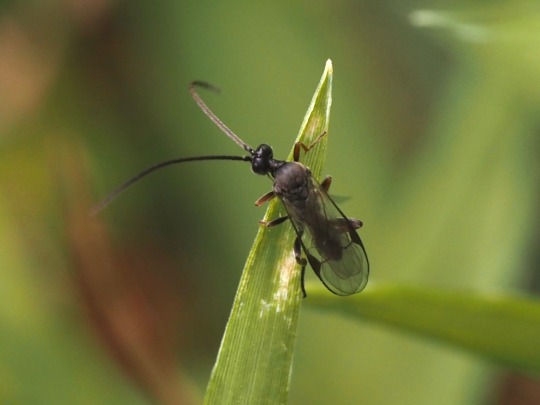
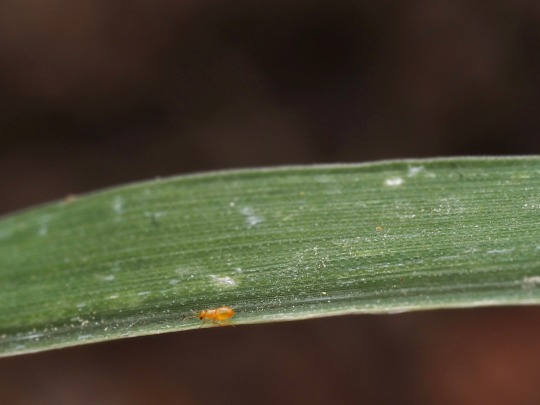
two parasitoids: a braconid ~3mm long & something else ~0.3mm long
the wasps most people take issue with are vespids, since they like the same foods we do (sweets, meat) and have powerful stings to defend their nests. these include the social hornets, yellowjackets, and paper wasps, but many mason wasps and the like are solitary (and, you guessed it, want nothing to do with people). vespids are great predators of caterpillars, flies, and other pests that humans don’t like in addition to being pollinators.
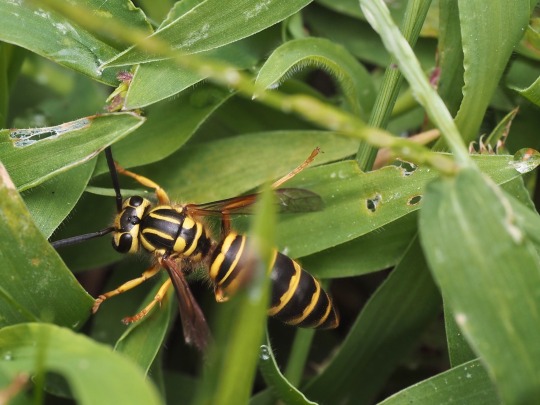
a yellowjacket: Vespula squamosa
the usual anti-wasp, pro-bee sentiments go: wasps attack for no reason, don’t pollinate, don’t make honey, and are “assholes.” wasps do pollinate (most wasps, bees and ants don’t eat solid food, and therefore largely drink flower nectar; some plants are only pollinated by wasps).
some tropical wasps do actually make honey, though it’s not harvested by humans. it’s sort of silly to say that making honey is what makes bees “good” though—a very selfish mindset, and for example butterflies are well-liked by people despite not making any edible products for us.
wasps also attack only when provoked, either because you’re near a wasp nest or when you lean on one accidentally. they are defending their baby sisters and themselves, same as bees would. at least in the US, I think the reason that wasps are so hated is that we have many species of paper wasp and yellowjacket that are willing to nest on or under houses, while the (invasive) honeybees prefer trees or are kept by beekeepers in artificial hives, so it’s just more likely you’ll run into problems with wasps than bees.
tl;dr:
wasps and bees are neither “nice” nor “mean.”
bees are mostly loners that don’t bother people. colonial bees will sting to defend their nests or themselves from predators. most bees are pollinators, who gather pollen to feed their larvae. a few species make honey that humans harvest.
wasps are mostly loners that don’t bother people. colonial wasps will sting to defend their nests or themselves from predators. most wasps are pollinators, and most hunt or parasitize other insects to feed their larvae.
1K notes
·
View notes
Note
What inspired your blog name?
This is very embarrassing but here goes: I'm the absolute worst at picking usernames and I had zero ideas when it came time to create my social media handle. So I went scrolling through my mountain of mostly-abandoned original stories… maybe I once created a OC with a cool name or something that I could bastardize… and behold, in the intro scene of one such story, the Stingless Wasp. A poor autonomous UAV that gets hacked while en route to drop bombs on the enemy, causing said bombs to fall on the wrong target, leading to much death and disaster and plot shenanigans. (Unfortunately there is no actual plot 😔)
TLDR: I'm named after a fictional drone that gets destroyed in the opening scene of my unfinished story. Luckily I've uncoupled my brain from that extremely odd association and now I find it cute when people call me wasp <3
127 notes
·
View notes
Text
Wasps in Flight

Personally, I've had some bad encounters with wasps, but Dr. Adrian Smith of Ant Lab feels the insects receive short shrift. In this video, he shows many species in the order -- most of which are venomless and stingless. (Video and image credit: Ant Lab/A. Smith) Read the full article
51 notes
·
View notes
Note
Hi! Could you do cottagecore or bee related names, pronouns and titles? Thanks! :]]
bees <3
names:
bee, beette, beetta, beelle, beella, bumble, bumblebee, buzz, beetrice, beetrix, beena, beech, barbee, baebee, beckett, beowolf/beowulf, behan, beeanca, biene wasp, worker, wing queen, queenie hornet, honey/honie, halbee, hive carpen, carpent, carpenter, collete, cobee, colbee sting, stinger, stingless, shelbee, swarm apidae, andrena, api, apis, abbee, albee, ambrose drone, darbee, debbee/debbie, debra, devri, debs melita, macabee/maccabee, melissa, melissae rubee kobee, kolbee, keeper gabee/gabbee erlea potnia, phoebee, pollen
3rd p prns: they/them/theirs/themselves
bee/bees, be/ee, bumble/bee, bee/keeper, bee/hive honey/honeys, honey/bee, hive/hives carpenter/bee, collete/collettes drone/drones, drone/bee api/apis, api/dae, api/apidae, apidae/apidaes, andrena/andrenas, andrenidae/andrenidaes, andren/idae work/worker, worker/bee, wing/wings sting/stinger, sting/stingless, swarm/swarms queen/queens, queen/bee pollen/pollens, pollen/pollinator
titles:
the bee, the bee hive, the bee keeper, the queen bee, the queen of bees, the bee swarm, the swarm of bees, the bees knees, the honey bee, the drone, the worker, the collette, the carpenter bee, the apis, the apis ruler, the apis hive, the apis keeper, the bumblebee, the andrena bee, the apidae, the andrenidae, the keeper of bees, the caretaker of the hive
(prn) who cares for bees, (prn) who pollinates, (prn) who keeps bees, (prn) who loves bees, (prn) who befriends bees, (prn) who is the bees knees, (prn) who loves among bees, (prn) who is trusted by bees, (prn) who rules the apis kingdom
#bee theme#bee names#names#name list#name searching#request#request answered#name blog#list of names#anon answered#title list#bee titles#bee pronouns#bee neos#bee neopronouns#bee/bees#3rd person pronouns#first names#baby names#name inspiration#name suggestions#name ideas#name help#latin names#greek names#pronoun list#pronouns#pronouns list#pronoun searching#pronoun suggestions
11 notes
·
View notes
Text
The project I'm MOST proud of so far though is Astar City, and that extended universe. Currently I'm trying my hand at a scientifically minded spec-bio project for one of the aliens featured there, the Aska'a Thani, but I don't have any details yet.
Instead, I'm going to gush about my bugs ♥️
The Viispaa species were made artificially by the Kuana as a means of interacting with humans early on; they have traits primarily taken from wasps and bees with human, Kuana and some other DNA snippets thrown in to make them intelligent and emotional, sentient creatures.


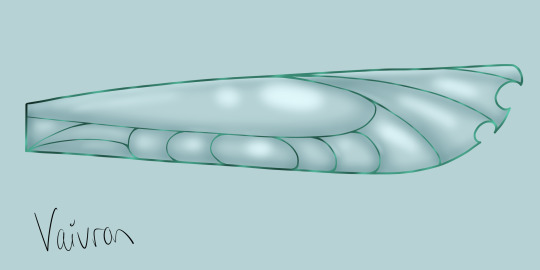
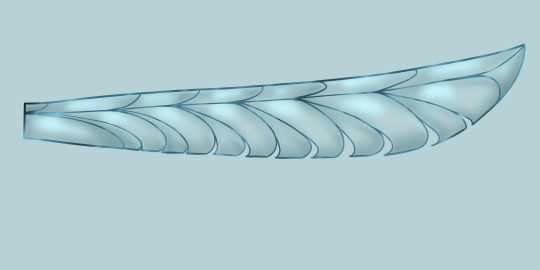
Viispaa Primes are the default, original variant, standing between 5-8 feet tall with heavy gender dimorphism and moderate coloration that sticks to the yellow and black scheme of most bees. In recent years, newer generations have gotten more colorful with new pigments being added in.
From this mold are many variations, some of which haven't been fully figured out yet. Above are the current examples of the standard: Vaivron (left) and Zivv (right), who are due to get a redesign to simplify their patterns a bit.
From them is a specific mutation only referred to as a "hornet".
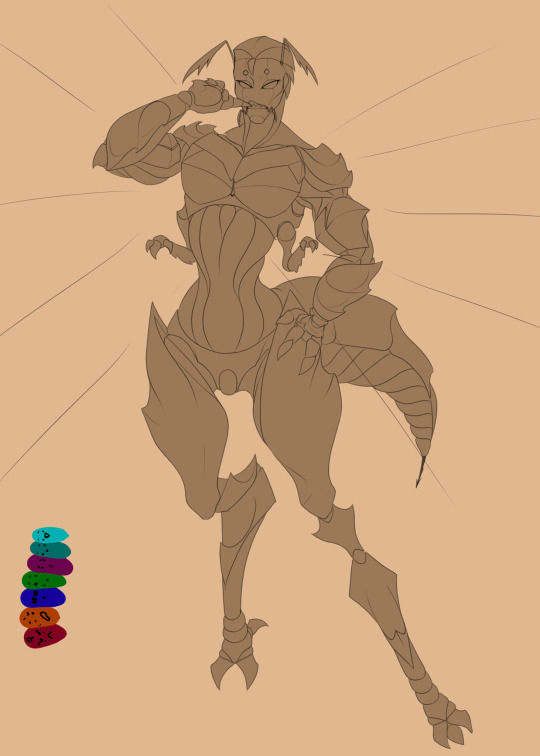
Hornets are easy to spot because of their sharper features and reddish-brown or black-blue coloration and are, well...
Angry lil bastards. The aggression that was dormant in the Primes becomes much more prominent in the Inimicus mutations, making them unpredictable; many of them are required therapy and stimulation to provide safe outlets for their anger, and often end up in labor jobs or in the military to help curb that behavior in a useful way.
They are not mindless, always raging beasts though, and tend to dislike that label. Many are fully aware of their triggers and how they feel and behave when set off, they don't always lose themselves to the anger, it's simply how they are and they take measures to control themselves. Usually.
Some are just assholes and want to get away with it because it's "how they are".
After them are the Puer.

Puer are the honeybee drones of the Viispaa species, majority of them being small, child-looking, genderless individuals who exist as safe companions to actual children. Called "nanny bugs", Puer drones are stingless and extremely hardy, meant to play with children and be able to go with them where they want to be when parents can't or won't follow. They come in an array of colors that make them popular and easy to spot amongst kids and parents alike, making it easy to find them in crowds and for little ones to identify their "safe bug".
While made for children, Puer are intelligent and can reason like adults in order to explain things as needed when kids can't communicate well, but often come off as childish themselves as they naturally know how to age regress to match the demographic they're part of.
Being genderless though, and sexless, Puer have to be bred from a Queen, much like a beehive.

Queens are called Zinnias and have a chance of morphing from a clutch of eggs at a rate of roughly 1:1,000. They can breed with any standard male wasp (including hornets) and are integral in the care of Puer drones, as well as being social safe zones. Zinnias are well protected and often sought for safety by children and young women, as where there is a Zinnia, there's likely one male wasp eager to protect her.
They can be spoiled rotten as well, as Zinnias with favorable color genes tend to be better off than regular ones.
After them are the Curantis, the fluffiest of the Viispaa.
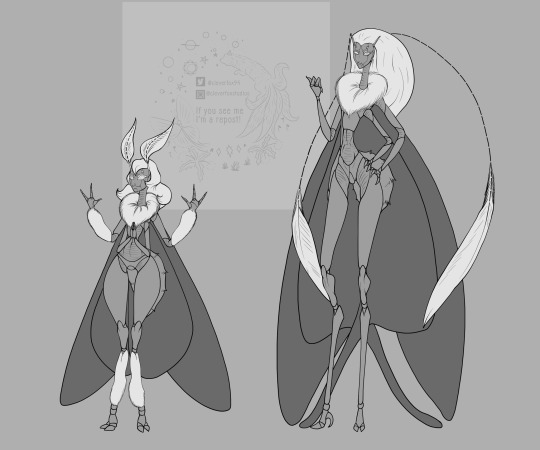
Being the first to fully deviate from the wasp body plan, Curantis were developed for a handful of reasons but mostly as not only an inverse of the Zinnia variant, but also as caretakers for non-children. With inherently friendly, positive dispositions, Curantis's ended up gravitating to mostly customer service and retail spaces, as they enjoy helping and chatting with others.
Astar City's customer service scene is very mindful of the well-being of the Curantis and thus customers don't get away with nearly as much nonsense as they do elsewhere, though you wouldn't catch a moth mouthing off to someone for no reason. Except the males.
Avalons are similar safety beacons to Zinnias and very easy to spot with their wings, but tend to be more crass and direct, as they're very protective by nature and dislike their wards being picked on by others.
Stay tuned for more bugs! There's quite a few variants left to go, including the Artifex (ants), a few military grade versions, and some spoopy Bois meant to do the dirty work :)
#bug#alien#oc#scifi#science#artificial#wasp#bee#hornet#moth#butterfly#viispaa#kuana#experiment#satellite
9 notes
·
View notes
Note
BEEEEEEEEEEEEEEEEEEEEEEEEEEEEEEEEE

Bees are winged insects closely related to wasps and ants, known for their roles in pollination and, in the case of the best-known bee species, the western honey bee, for producing honey. Bees are a monophyleticlineage within the superfamily Apoidea. They are currently considered a clade, called Anthophila.[1] There are over 20,000 known species of bees in seven recognized biological families.[2][3][4] Some species – including honey bees, bumblebees, and stingless bees – live socially in colonies while most species (>90%) – including mason bees, carpenter bees, leafcutter bees, and sweat bees – are
solitary.
Bees are found on every continent except Antarctica, in every habitat on the planet that contains insect-pollinated flowering plants. The most common bees in the Northern Hemisphere are the Halictidae, or sweat bees, but they are small and often mistaken for wasps or flies. Bees range in size from tiny stingless bee species, whose workers are less than 2 millimetres (0.08 in) long,[5] to Megachile pluto, the largest species of leafcutter bee, whose females can attain a length of 39 millimetres (1.54 in).
Bees feed on nectar and pollen, the former primarily as an energy source and the latter primarily for proteinand other nutrients. Most pollen is used as food for their larvae. Vertebrate predators of bees include primates and birds such as bee-eaters; insect predators include beewolves and dragonflies.
Bee pollination is important both ecologically and commercially, and the decline in wild bees has increased the value of pollination by commercially managed hives of honey bees. The analysis of 353 wild bee and hoverfly species across Britain from 1980 to 2013 found the insects have been lost from a quarter of the places they inhabited in 1980.[6]
Human beekeeping or apiculture (meliponiculture for stingless bees) has been practised for millennia, since at least the times of Ancient Egypt and Ancient Greece. Bees have appeared in mythology and folklore, through all phases of art and literature from ancient times to the present day, although primarily focused in the Northern Hemisphere where beekeeping is far more common. In Mesoamerica, the Mayans have practiced large-scale intensive meliponiculture since pre-Columbian times.[5]
Get Wikipedia articled.
2 notes
·
View notes
Text
Bees Control in Melbourne: Expert Solutions for Safe and Humane Removal

365 Pest Control Melbourne- Over 20 years of experience in Providing Professional Pest Control in Melbourne. Provides residential and commercial pest control services for termites, rats, bedbugs, cockroaches, bees & wasps, spiders, mites, millipedes, mosquitoes, earwigs, fleas, and ants.
Bees are fascinating creatures that contribute immensely to our environment, yet their presence in urban areas can pose significant challenges. Bee infestations in Melbourne homes or businesses often require immediate and professional intervention. This article expands on the critical role of bees control Melbourne services, explaining not only the practical aspects of removal but also the legal and ecological factors that make professional help essential. With the ever-growing concern over environmental conservation, the responsible handling of bees is more important than ever.
Legal Considerations for Bees Control in Melbourne
In Melbourne and across Australia, bees are protected due to their role in pollination and the environment. In fact, killing bees without just cause is frowned upon, especially when they can be relocated instead. Certain species, like the European honeybee, are vital for agriculture and ecosystem health. Therefore, when you need bees control near me, it’s essential to choose a service that understands the legalities surrounding bee removal and relocation.
Licensed Pest Control Operators: Only licensed and trained professionals can legally handle the removal and relocation of bee colonies. They follow strict regulations that prioritize humane methods, ensuring the bees are safely relocated to new habitats where they can continue their pollination work without causing harm to people.
Protected Species: Some native bees, particularly stingless species, are protected by law. Bees control Melbourne experts understand which species require special handling and make sure that legal and ethical guidelines are followed.
Seasonal Factors and Bees Activity in Melbourne
Bees are most active during the warmer months, which means bee infestations typically peak in the spring and summer seasons. As the temperature rises, bees become more industrious, seeking out new locations to establish hives. This seasonal increase in bee activity often leads to higher demand for same day bees control services as property owners discover new colonies forming.
Springtime Swarming: In spring, bees begin to reproduce and split their colonies, leading to swarming. This is when a group of bees leaves their original hive to establish a new one. Swarming bees are typically not aggressive, but they can be intimidating and pose a risk if they settle near homes or public spaces. During this season, bees control emergency services are frequently called upon to manage these situations safely.
Summer Hive Expansion: During the summer months, bees focus on expanding their hives and collecting nectar. As hives grow, they can become more defensive, especially if they feel their colony is threatened. If a large hive is discovered in a risky area, calling a same day bees removal service becomes essential to avoid any potential harm.
Winter Hive Dormancy: Although bees are less active in winter, it’s still possible to discover hives in attics, wall cavities, or garden sheds. Bees tend to retreat indoors to protect themselves from colder temperatures. This is why it’s crucial to stay vigilant year-round and address infestations before they become a bigger problem.
Bees Relocation: A Focus on Ecological Responsibility
Given the growing awareness around environmental conservation, one of the key components of modern bees control Melbourne services is the safe and humane relocation of bee colonies. Rather than exterminating bees, professionals focus on relocating them to areas where they can thrive without posing risks to humans.
Why Relocate Bees? Bees are vital pollinators, playing a significant role in food production and the survival of plants and ecosystems. By relocating hives instead of destroying them, professional same day bees removal services ensure that the local bee population remains intact, which helps maintain the balance of nature.
How Relocation Works: When experts remove a bee colony, they carefully extract the bees and their hive, placing them in specialized transport containers. These containers are designed to keep the bees safe during transportation. Once the bees have been removed, they are relocated to designated apiaries or natural reserves where they can continue their pollination activities without risk to human populations.
Post-Relocation Monitoring: In some cases, bee control services may follow up after the removal to ensure the bees have safely adjusted to their new environment. This careful attention to the welfare of the bees ensures that their ecological function remains uninterrupted.
Protecting Your Property from Future Bee Infestations
After a successful bee removal, it’s crucial to take preventive steps to avoid a similar issue in the future. Experienced bees control Melbourne professionals not only remove the immediate threat but also provide guidance on how to safeguard your property from future infestations.
Sealing Entry Points: One of the most effective methods of prevention is identifying and sealing any potential entry points that bees might use to access your home. This includes cracks in walls, openings in the roof, and unsealed vents. Technicians can inspect your property for these vulnerabilities and recommend the best course of action.
Bee Deterrent Landscaping: Certain plants and flowers are more likely to attract bees. While it’s not necessary to eliminate all pollinator-friendly plants from your garden, positioning them away from high-traffic areas, such as doorways or patios, can help reduce the likelihood of bees nesting nearby.
Regular Inspections: Routine inspections from pest control professionals can help catch early signs of bee activity before they become problematic. Having experts assess your property regularly will ensure that any developing hives are dealt with before they pose a risk.
The Role of Wasps Control in Melbourne’s Pest Management
While the focus is often on bees, wasps can also be a significant concern, particularly in summer. Wasps are more aggressive than bees, and unlike bees, they can sting multiple times. Their nests are often hidden in hard-to-reach places like roof eaves, wall voids, and garden sheds.
Professional wasps control Melbourne services offer the expertise to identify, treat, and eliminate wasp nests before they become a danger. Wasps can become particularly problematic when their nests are located near food sources, such as outdoor dining areas or bins. Unlike bees, wasps often require more aggressive control measures, including the use of targeted insecticides that can only be applied by licensed professionals.
How Professional Bees and Wasps Control in Melbourne Can Benefit You
Choosing the right pest control service is critical for ensuring your home or business is protected from bees, wasps, and other pests. Here’s how professional bees control Melbourne and wasps control Melbourne services offer peace of mind:
Licensed and Trained Technicians: Experts are well-trained in the safest and most effective removal techniques, using equipment and methods that protect both people and the environment.
Same Day Services: For urgent infestations, same day bees removal and bees control emergency services provide quick and reliable solutions, ensuring the problem is dealt with before it escalates.
Eco-Friendly Solutions: Responsible pest control services prioritize bee relocation, protecting pollinators while keeping your property safe.
Prevention Strategies: Professional pest controllers don’t just remove the problem — they work with you to implement long-term prevention strategies that reduce the risk of future infestations.
Conclusion
Bee infestations in Melbourne, while important to address quickly, require expert knowledge and a careful approach due to the bees' essential role in the environment. Whether you’re dealing with a full-blown hive inside your walls or have spotted a swarm in your garden, professional bees control Melbourne services can provide the fast, effective, and eco-conscious solutions you need.
0 notes
Text
Let’s talk about Singapore wildlife woo!!
As a city with lots of greenery, animals can be found everywhere across the place. When you find a moderately-sized lizard (invasive unfortunately), or perhaps a wasp nest on a random sign, you know they did something right.

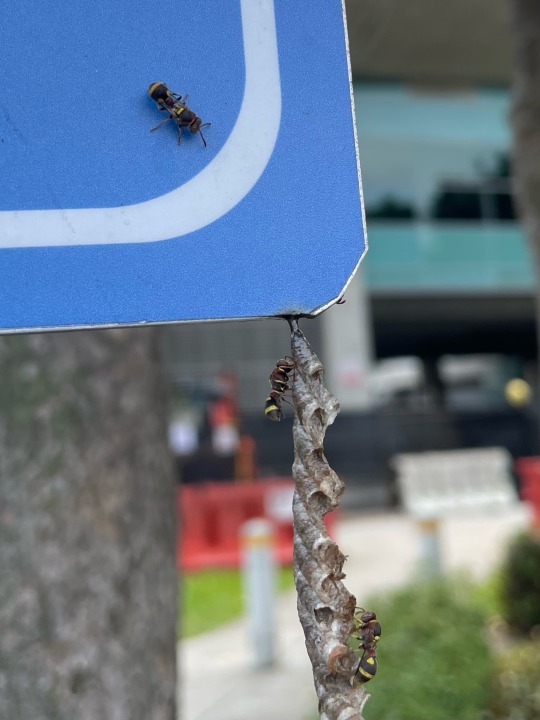
With a similar climate compared to Hong Kong, you can find some familiar faces, such as this Okinawa mud wasp.

However, the native wildlife for the most part, is completely different. Check out this wasp moth (close relatives can still be found in HK) and stingless bee. Maybe even a wandering glider, or an amorphoscelis mantis.

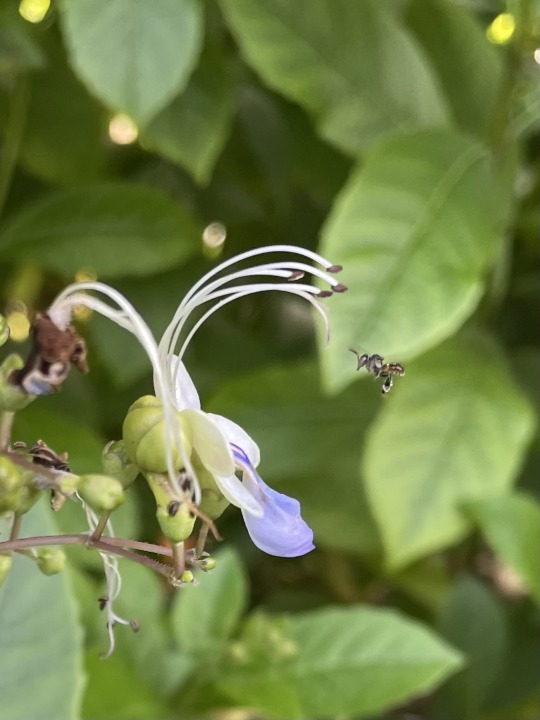


Common birds include the zebra dove, spotted dove, house crow and javan myna (I don’t like them).

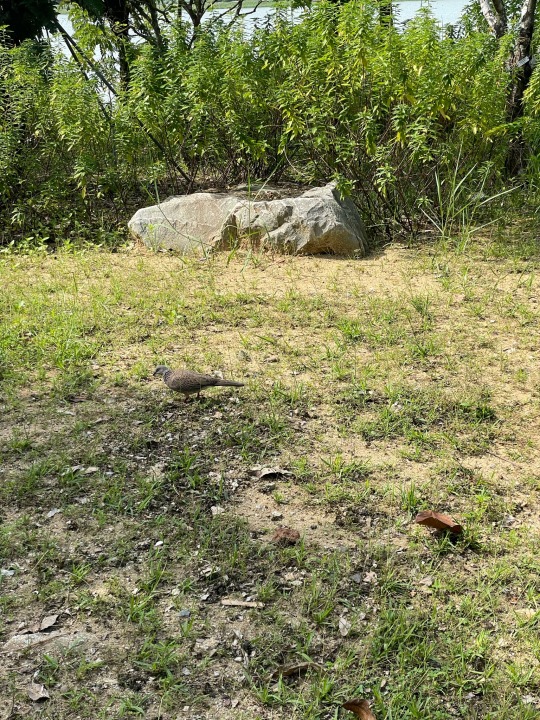


Also saw a collared kingfisher and a peacock (invasive).

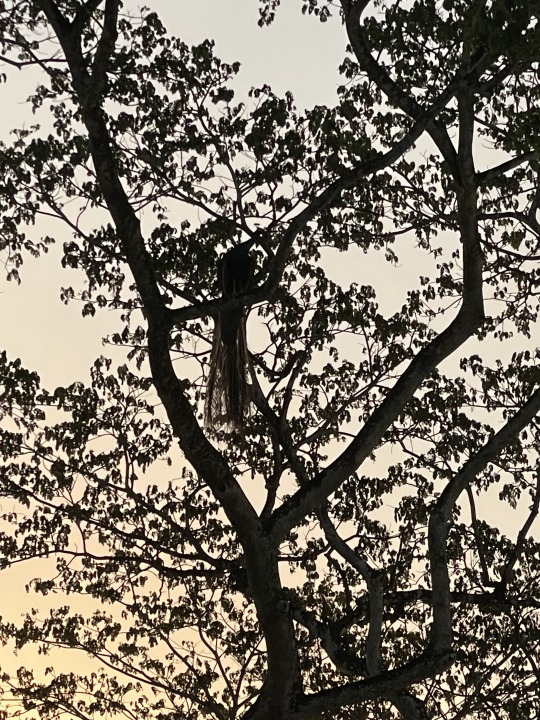
There are actually 2 species of monitor in Singapore: the Asian water monitor and the clouded monitor, which I unfortunately didn’t get the chance to meet, maybe when I come back here later…
1 note
·
View note
Note
without any size comparison how can you tell queen yellowjackets (and any kind of wasp/bee i guess?) from nonqueens?
varies between groups
bumblebee queens are often much fluffier and brighter-colored than the workers. you’ll likely never see them, but many stingless bee queens are bloated “physogastric” like termite queens. Polistes queens look almost identical to their offspring. yellowjackets can vary widely, queen V. squamosa are light orange versus the workers' thin yellow and black bands, while V. germanica queens look pretty much the same as the workers. species that have less advanced eusociality like paper wasps often have no discernible differences between a nest-founding female and workers (who can still reproduce but are bullied to suppress that).
56 notes
·
View notes
Text
New England researchers optimistic a tiny wasp is turning the tide against emerald ash borer | WBUR News
The stingless wasp is tiny – about the size of a mosquito. But scientists have big hopes for it. In Russian forests, where the wasp is originally from, it naturally targets and attacks emerald ash borer. — Read on www.wbur.org/news/2023/02/21/new-england-research-wasp-emerald-ash-tree-borer
View On WordPress
0 notes
Note
I've learned about a cool bug and I've decided to make it everyones problem!!
Hello there my good fellow, have you ever heard of vulture bees?
No? Yes? I'll just tell you anyway
Vulture bees are a small group of closely related South American stingless bee species of the genus Trigona and they feed on rotten meat, and instead of honey they make a honey like substance made from the protein rich secretions of the bees hypopharyngeal glands,
In other words, corpse honey !
And if that wasn't metal enough they also kill wasp larvae.
Anyways have a nice night/day!
P.s I think your leeches are awesome, personally I think leeches would not be a good pet for me but I think its really neat how some people have them as pets and how they are used in the medical field! They're just fascinating critters in general.
I think I may have heard about vulture bees sometime in the distant past but it is always good to be reminded. I love people with Insect Blorbos, Godspeed you funky little Bee Guy
45 notes
·
View notes
Note
Sup, its me again! Hope your having a good day!
I have come to tell you about my new favorite insect, vulture bees! I just think their so neat and want to share about them.
Vulture bees are a small group of closely related South American stingless bee species of the genus Trigona which feeds on rotting meat, instead of honey they make a honey like substance made from the protein rich secretions the bees hypopharyngeal glands! In other words they turn corpses into honey!
If that wasn't metal enough they also kill wasp larvae! They don't sting though,they don t even have stingers! They do bite though, they have strong jaws to carry bits of carrion and stuff. (They eat alittle fruit and stuff as well)
Again have a nice day, remember to drink water,and thanks for reading!
I am ever astounded by the diversity and specialization of bees that exist! What absolutely wonderful creatures, thank you for sharing!
15 notes
·
View notes
Text
"wouldn't inventing farmable foods that don't require pollination by bees" We have plenty. We had a whole world growing food before that bee was bred as the sole pollinator.
We created a monoculture where one organism was responsible, we made it as inbred as possible, and then we act shocked when it is subject to a population collapse.
There are plenty of native bees.
How has the eradication effort affected native bees?
In an effort to rid Australia of this devastating European honeybee parasite, the DPI tried to destroy all feral European honeybee colonies that were nesting in tree cavities in the Red Zones. By September 2023, the combined Red Zone areas covered over 1.5 million hectares.
The DPI eradication effort in the Red Zones involved the use of baits laced with the highly toxic pesticide, Fipronil. Pesticide residues in the environment could still impact local native bees and other pollinators in some of these areas.
The government, as part of its quest to eradicate the sole bee we depend on for survival, has been carpet bombing native bees, for our protection, for the collective good. You can't save the village if you don't destroy it. So here's an idea. Imagine if the politicians all spontaneously combusted. Would we starve? Hell, no. The mite infestation of this one species of bee we have been made to be dependent on can be ignored by simply using one of the literal thousands of alternatives. We do not need that one inbred species of bee; however, from the corporatist perspective, making humanity totally dependent is a good thing. "This crisis highlights the vital importance of developing native bees as alternative pollinators for Australian agricultural crops. As Varroa Mites gradually spread across the country, massive losses of European honeybees will occur throughout Australia. The pollination services of native bees and other insects will become crucial to support Australian agriculture.
Recent research in Australia has demonstrated that native bees, including our stingless bees and blue banded bees, can be effective pollinators of many Australian agricultural crops. Other Australian native insects, including flies, beetles, butterflies and wasps, also contribute important pollination services to crops."
When State and Corporation merge into one, when the State tells you to panic, that you will die unless you stop thinking and learn to love Big Brother, I tend to listen to that cynical voice that has heard all of this for fifty years now, and that has read it happening a thousand years before I was born.

Why was it so important to eliminate native bees in Australia?

Why would some elite want us peasants broken and starving?


When are we going to start lynching scientists, no need for bees my ass.
477 notes
·
View notes